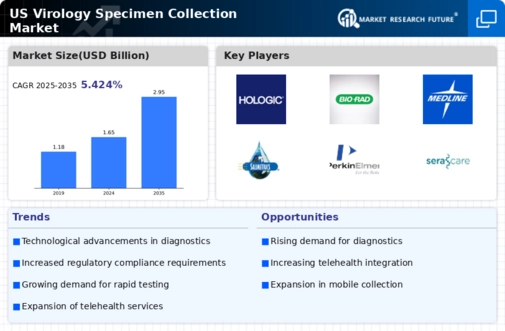Emergence of Point-of-Care Testing
The emergence of point-of-care (POC) testing is reshaping the landscape of the virology specimen-collection market. POC testing allows for rapid diagnosis and immediate treatment decisions, which is particularly crucial in managing viral infections. The convenience and speed of POC testing are driving its adoption across various healthcare settings, including clinics and emergency departments. Market analysis indicates that the POC testing segment is expected to grow at a CAGR of around 8% over the next few years. This growth is likely to stimulate demand for innovative specimen-collection devices that are compatible with POC testing methodologies, thereby enhancing the overall efficiency of the virology specimen-collection market.
Rising Demand for Diagnostic Testing
The increasing prevalence of viral infections in the US has led to a heightened demand for diagnostic testing, which directly influences the virology specimen-collection market. As healthcare providers strive to enhance patient outcomes, the need for accurate and timely testing has become paramount. According to recent data, the diagnostic testing market is projected to grow at a CAGR of approximately 7% over the next few years. This growth is likely to drive investments in specimen-collection technologies, thereby expanding the virology specimen-collection market. Furthermore, the emphasis on early detection and preventive healthcare measures is expected to further bolster the demand for efficient specimen-collection methods, ensuring that healthcare facilities are equipped to handle the increasing volume of tests.
Integration of Automation in Laboratories
The integration of automation technologies in laboratories transforms the virology specimen-collection market. Automated systems enhance the efficiency and accuracy of specimen handling, reducing the risk of contamination and human error. As laboratories seek to optimize workflows, the adoption of automated specimen-collection devices is on the rise. Reports indicate that the automation market in laboratories is expected to grow significantly, with a projected increase of around 10% annually. This trend suggests that laboratories are increasingly investing in advanced technologies to streamline operations, which in turn is likely to create a favorable environment for the virology specimen-collection market. The shift towards automation not only improves operational efficiency but also enhances the overall quality of diagnostic testing.
Growing Investment in Healthcare Infrastructure
The ongoing investment in healthcare infrastructure in the US is a significant driver for the virology specimen-collection market. As healthcare facilities expand and modernize, there is an increasing need for advanced specimen-collection technologies to support enhanced diagnostic capabilities. Government initiatives aimed at improving healthcare access and quality are likely to result in substantial funding for laboratory upgrades and new equipment. Recent reports suggest that healthcare infrastructure spending is projected to increase by approximately 12% over the next few years. This trend indicates that the virology specimen-collection market will benefit from improved facilities and resources, ultimately leading to better patient care and more efficient specimen-collection processes.
Increased Focus on Infectious Disease Surveillance
The growing emphasis on infectious disease surveillance in the US is a critical driver for the virology specimen-collection market. Public health agencies are prioritizing the monitoring of viral outbreaks to ensure timely responses and effective containment strategies. This focus has led to increased funding for surveillance programs, which in turn drives demand for specimen-collection services. Data from health organizations indicate that funding for infectious disease surveillance has seen a notable increase, with allocations rising by approximately 15% in recent years. This trend suggests that the virology specimen-collection market will benefit from enhanced resources and support, enabling more comprehensive data collection and analysis to inform public health decisions.






















Leave a Comment